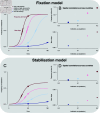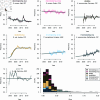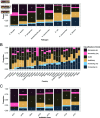The evolution of antibiotic resistance in Europe, 1998-2019
- PMID: 40179072
- PMCID: PMC11967945
- DOI: 10.1371/journal.ppat.1012945
The evolution of antibiotic resistance in Europe, 1998-2019
Abstract
The evolutionary dynamics of antibiotic resistance are not well understood, particularly the long-term trajectories of resistance frequencies and their dependence on antibiotic consumption. Here, we systematically analyse resistance trajectories for 887 bug-drug-country combinations in Europe across 1998-2019, for eight bacterial species with a considerable resistance-associated public health burden. Our analyses support a model in which, after an initial increase, resistance frequencies reach a stable intermediate equilibrium. The plurality (37%) of analysed trajectories were best described as 'stable' (neither increasing nor decreasing). 21% of trajectories were best described as 'stabilising' - i.e. showing a transition from increasing frequency to a stable plateau; 21% as decreasing and 20% as increasing. The antibiotic consumption in a country predicts both the equilibrium frequency of the corresponding resistance and the speed at which this equilibrium is reached. Moreover, we find weak evidence that temporal fluctuations in resistance frequency are driven by temporal fluctuations in hospital antibiotic consumption. A large fraction of the variability in the speed of increase and the equilibrium level of resistance remains unexplained by antibiotic use, suggesting other factors may also drive resistance dynamics. Overall, our results indicate that ever increasing antibiotic resistance frequencies are not inevitable.
Copyright: © 2025 Emons et al. This is an open access article distributed under the terms of the Creative Commons Attribution License, which permits unrestricted use, distribution, and reproduction in any medium, provided the original author and source are credited.
Conflict of interest statement
The authors have declared that no competing interests exist.
Figures





Similar articles
-
[Antibiotic resistance : situation in Europe and Switzerland, and impact for the physician].Rev Med Suisse. 2016 Oct 12;12(534):1699-1702. Rev Med Suisse. 2016. PMID: 28686394 French.
-
Evolution of Drug Resistance in Bacteria.Adv Exp Med Biol. 2016;915:49-67. doi: 10.1007/978-3-319-32189-9_5. Adv Exp Med Biol. 2016. PMID: 27193537 Review.
-
From Petri Dishes to Patients to Populations: Scales and Evolutionary Mechanisms Driving Antibiotic Resistance.Annu Rev Microbiol. 2024 Nov;78(1):361-382. doi: 10.1146/annurev-micro-041522-102707. Epub 2024 Nov 7. Annu Rev Microbiol. 2024. PMID: 39141706 Review.
-
Antibiotics and antibiotic resistance genes in natural environments.Science. 2008 Jul 18;321(5887):365-7. doi: 10.1126/science.1159483. Science. 2008. PMID: 18635792
-
The evolution of antibiotic resistance: insight into the roles of molecular mechanisms of resistance and treatment context.Discov Med. 2010 Aug;10(51):112-8. Discov Med. 2010. PMID: 20807471 Review.
Cited by
-
Quantifying the effects of antibiotic resistance and within-host competition on strain fitness in Streptococcus pneumoniae.PLoS Biol. 2025 Aug 5;23(8):e3003300. doi: 10.1371/journal.pbio.3003300. eCollection 2025 Aug. PLoS Biol. 2025. PMID: 40763153 Free PMC article.
References
-
- Siira L, Rantala M, Jalava J, Hakanen AJ, Huovinen P, Kaijalainen T, et al.. Temporal trends of antimicrobial resistance and clonality of invasive Streptococcus pneumoniae isolates in Finland, 2002 to 2006. Antimicrob Agents Chemother 2009;53(5):2066–73. doi: 10.1128/AAC.01464-08 - DOI - PMC - PubMed
MeSH terms
Substances
LinkOut - more resources
Full Text Sources
Medical

